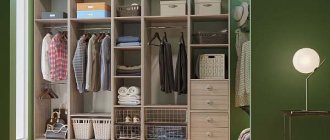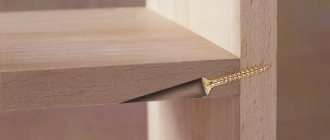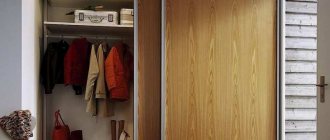A new day is coming, it’s time to go to the closet and choose clothes for yourself that would suit both your planned events and your mood. But it often happens that there are a lot of things, but nothing to wear - one is dirty, the second is wrinkled, the third is not liked at all. To avoid such problems, you should spend a little time on your wardrobe. There should be order in the closet - this will affect both the condition of the clothes themselves and the mood of their owner.
How to conveniently arrange things in a closet?
Your “Nothing to Wear” has nowhere to put it!
A phrase that every husband will subscribe to.
I have written more than one useful article about wardrobe revision and analysis! Today we’ll talk about whether order in the closet is achievable and exactly how you can arrange and hang all things and accessories on shelves and hangers so that all the necessary clothes are always at hand!
Every girl is familiar with Narnia. And he knows exactly where this very Narnia is. In her closet with clothes. That’s for sure - a magical world in which it is unclear what goes where and where everything is. In the most severe cases, unable to withstand the pressure of magic from within, the doors of the closet fall off or the shelves collapse. This happened to me with my shoe closet.
How many times when going through your wardrobe do you say: “Oh, what a cute blouse-skirt-sandals! Wow, I completely forgot about them!” Or, having acquired another new thing, you remember that somewhere in the depths... on the farthest shelf... the new is the well-forgotten old, yeah. Now in duplicate.
Wardrobe cleaning process
Before you begin to properly organize your space, you should “sort out the rubble” by studying what is generally stored in the deep depths of your wardrobe. There are several simple rules for this.
- Working from scratch. Shifting clothes from place to place in a closet packed to the brim makes absolutely no sense. Take everything out of the furniture, sort through it and sort it. Only after this simple fraud do you put all the neat piles back. We guarantee that you will definitely find things that you have already forgotten about.
- Checking clothes for the season. Before putting summer or winter clothes into “standby mode,” inspect them thoroughly. If a button comes off, sew it on, if a stain appears, wash it. Put each item in full combat readiness so that, as soon as necessary, you can take it out of your wardrobe, put it on and go about your business. Agree, it will be a shame when in the first frosts you take out your jacket and its zipper is broken or there is a stain on the sleeve.
- You cannot hang something that is easier to fold or vice versa. Foldable: items decorated with beaded embroidery, cashmere items, wardrobe items made of denim or any delicate fabrics. Hanging: trousers, dresses, shirts, skirts.
- Minimalism in boxes. The downside of storing things in boxes is the creation of a shaky structure that goes far to the ceiling. If seasonal clothing is stored in such containers, then this option is acceptable, but for items of daily use, limit yourself to a couple of boxes. A large number of cardboard boxes will be inconvenient to take out and put back in place.
- Don’t despair if you can’t clean it up once and for all. You need to develop a habit.
- Have a sale. For every new item, there are two old ones that should have been disposed of long ago. Charitable foundations, orphanages, those in need - there are many places where your unnecessary ballast will do more good than lying in the wardrobe.
VISIBLE SPOT
The saying “out of sight, out of mind” also affects memory when it comes to wardrobe. If you don't see a thing, then, as a rule, you don't remember it. And the result is the same sets of things that are constantly in sight. Boring. All you have to do is arrange things so that they can be seen. This, in my opinion, is the main purpose of organizing your wardrobe.
A clothing dump can bring another unpleasant surprise: suppose you suddenly remember a beautiful cardigan that hasn’t been worn for a hundred years. And we decided to take him for a walk. And when they took it out of the deposits, they discovered that it was all crumpled and there were no buttons. It’s good if you have time to put it in order and a button, but what if not? In this case, the item is very often sent back to the pile, where it will lie until it is thrown away or given away. And you could wear it with pleasure.
Do you think this is a rather bleak picture?
So, let's begin to restore world harmony within the framework of a single wardrobe. First you need to determine in what position each item will be stored. Will it hang on a hanger, put it on a shelf, or be stored in a box? The storage method depends, first of all, on the purpose of the item, the type of material and frequency of use.
And the basic rules for organizing “closet” space are as follows:
- We do not buy a cabinet, but order it individually. Moreover, if the space of the apartment does not allow you to install a huge wardrobe that covers the entire wall or make a beautiful, comfortable dressing room. We order the closet right up to the ceiling in order to put things that you take out once every year or two compactly at the top.
- We zone the space in the closet, highlighting zones for each type of thing. The narrower the racks and shelves, the more compactly things can be stored.
- We use it for convenience and external aesthetics of the box. You can use shoe boxes, beautiful designer boxes, baskets or transparent containers. You can put a sticker on each box with an inscription so you don’t forget where your favorite T-shirt with a yellow smiley face and a swimsuit that can be worn in 3 ways are located.
- We lower the most popular items to eye level. Everything we wear less often is at the bottom, the rest goes to the very top.
- When ordering furniture, plan for more drawers at the bottom of the cabinet! They save space and allow you to fold things compactly and beautifully, at the same time hiding them from prying eyes.
- Don't miss a single centimeter of closet space! Even the doors must be used!
- Remember about seasonality! Separate your spring, winter and summer clothes right away so you don’t have to dig out flip flops and fashionable shorts between sweaters and deer socks.
- If you are a true fashionista, and you can get lost in your closet, then divide things by shade to make it easier to find a yellow blouse to match black trousers. You can even arrange things in a “gradient” pattern so that pleasant color transitions will please the eye of every perfectionist guest.
- We use all modern devices designed to make it easier to find things in the closet - from baskets and containers to special hooks and hangers.
HANGERS
Now let’s take hold of the hangers and throw out all the wire misunderstandings, slanted planks and plastic monsters 3 sizes too large that have crept into your closet. This trinity can cause irreparable damage to delicate and thin tissues or skin. Wire hangers are needed to bring clothes from the dry cleaner or workshop. All. You cannot store clothes on them! Under its own weight, the fabric stretches, and the thin frame of the hanger is very easily deformed. And, once again taking out your favorite jacket, you may find “ears” on the shoulders or sleeves (if the hanger is the wrong size), similar in shape to the ugly bubbles of sweatpants, only small. I'm not even talking about the exquisitely colored rust stains on a light jacket, for example.
Option two - wooden hangers. Just please, not the creepy two-plank designs that remember your mother’s prom dress. But wide ones with rounded ends are what you need. The only thing is that things can easily slip off from patent-leather hangers, so fasten the buttons. The advantages of such hangers are at the same time their disadvantage: they are solid, beautiful, take up a lot of space in the closet and are expensive. Such a Bentley among hangers. This category, very beautiful and very expensive, includes hangers covered with leather.
If functionality is most important to you, then welcome to the world of plastic hangers. But not powerful cast monsters on which you can hang knight's armor, and nothing will survive. The crossbar next to the closet will probably break. Plastic hangers are very convenient for putting things in order. Lightweight, functional, for delicate thin fabrics there are silicone pads so that silk or cambric does not slip off.
The most ideal, in my experience, are vinyl coated hangers. If anyone is sad about the thinness of wire, this is the place for you. They are almost as thin, but they no longer pull clothes because of their size, a lot of them can fit in a closet, and the special coating, that same vinyl (yes, it turns out that not only records are made from it), does not allow them to slip and become deformed even the thinnest and most delicate fabrics.
A general rule for all hangers: they should be the right size for you! It is necessary. Too large will cause bubbles on the sleeves, and too small will cause bubbles on the shoulders.
It is also recommended that all hangers be the same, so that when you open the closet, you see an orderly row of hanging clothes, and not sleeves and shoulders sticking out at random.
A few words about fabric hangers: they look very cute, ideal for thin blouses, but take up a lot of space. One way out: take out one or two shelves in a closet with shelves, nail a crossbar in the resulting space and hang soft hangers with blouses on it.
A general rule for everyone: hangers should be smooth, with recesses for straps or special loops for skirts or dresses. Some models have a crossbar or tucks for trousers. Whether you use them or not is up to you. Just keep in mind that in this position the trousers may wrinkle.
If ironing is not so scary for you, then you can save space by purchasing these hangers for your trousers.
What is not recommended to be stored on hangers is knitwear, especially thin ones, woolen sweaters, cardigans and other fabrics that can deform under their own weight. It is best to fold them in neat piles, sorted by density.
A little trick: alternate in one pile, say, sweaters or tops, bright and dark. This way they will be more noticeable and will not merge with each other. The same stacks are convenient for storing jeans.
Some people prefer to store knitted items vertically in a chest of drawers or drawers, as the Japanese do. To learn more about this method, read Marie Kondo's book The Magic of Tidying Up. But let me note right away that this method is not suitable for everyone. Didn't suit me. Things get very wrinkled 
And this is a life hack for girls who especially like to plan everything. I learned about it from my basic course student, who approached all tasks very responsibly.
After a total revision of her wardrobe, she photographed ALL her looks, sent them to me, we adjusted them a little, and then she just took and hung her photos on the inside of the closet doors. She no longer faced the question of “what to wear.” 
I think it's brilliant!
"Weeding" the wardrobe
First you need to find out what clothes and how many you have. If you store clothes in different places at home (for example, in the hallway - coats and hats, and in the basement - carnival costumes that you wear extremely rarely), take them all to the bedroom. Your first goal is to wash and clean absolutely all the things you have and collect them in one place. This might be an eye opener to your inventory.
Remove the plastic film from clothing that stores and dry cleaners use to protect them from contamination during transportation. Over time, it begins to decompose, damaging the fabric and leaving stains. Trim off any colored identification tags attached to dry-cleaned garments, as dye from the paper may transfer to the fabric. For long-term storage of clothes (for special occasions and suits), cotton bags or made from durable plastic materials are better suited.
Once you have washed, cleaned and collected all your items in one place, answer the following questions:
- What is your attitude towards your clothes?
- What types of clothes (work, workout, dressy) do you have?
- Are there any patterns in your wardrobe (recurring colors, styles, sizes, seasonality)?
I confess that the first question is too personal. But it still needs to be answered. If, when you look at a mountain of clothes, you are frightened by its exorbitant amount, this is a sure sign that it’s time to get rid of many things.
The answer to the second question will give you a hint on where to start decluttering. If you rarely go to formal or formal events, but you have three tuxedos or fifteen ball gowns, then it becomes clear how you can free up space in your closet. The same approach applies to workout clothes: if you don't wear them, get rid of them.
The answer to the third question will determine the criteria for dividing things into two categories - those that will remain in your wardrobe, and those that you will have to say goodbye to.
You probably have certain clothing preferences. You may notice some patterns in the selection of color (for example, I categorically do not accept bright colors), or fabric (almost all of my clothes are made from natural fibers), or cut (I prefer tight clothes to baggy ones).
At the same time (while all the clothes are unloaded onto the bed), assess the condition of your wardrobe (but empty it completely first) What is it like? Is the cabinet in need of repair? Does it meet your storage needs? If it needs repainting, repairing, vacuuming, adding extra hooks or new slats, or any other work, do it now while it's empty. Ultimately, its size determines the amount of stuff you can have; Keep this in mind as you continue to sort your wardrobe.
BAGS: HOW TO STORE IN THE CLOSET?
In the lower (or upper) part of the cabinet, in special cases, stuffed with paper inside. This way, creases do not form on them, and the surface does not get dirty.
Of course, there is not always enough space in the closet for bags. There will be much more space for them in a full-fledged dressing room.
Small bags and crossbody can be conveniently hung on hooks. You can use a regular scarf hanger or special hangers, like in the picture on the right.
Or order such hanging organizers on AliExpress 
Belts, scarves, shawls. Welcome to IKEA! This is truly a paradise for lovers of order. Hangers, rails, boxes for accessories, storage modules, drawers with dividers - a paradise for those who like to organize everything.
Don't neglect your little helpers
You can attach a special organizer for underwear and socks to the closet door
When keeping things tidy, it is not recommended to give up using various hangers, organizers, and wicker baskets. Little helpers allow you to save space and implement a competent storage system.
We hang ties, straps and belts on the door or, roll them into “snails”, hide them in special organizers
Anything that doesn’t have a place in your wardrobe can be moved to a basket or container. You should label them with a description of what's inside to improve ease of use. There are special cells where ties and underwear are placed.
Special organizers make life much easier; you can neatly organize all your underwear and other small items in them.
HOW TO HANG SCARFS?
The main task is still the same: they must be visible, so boxes and crates are not suitable for this purpose; a moth will get to the scarf lying at the bottom of the box much faster than you. So, either in a stack on a shelf, or, if there are not many of them, hang them on special structures, of which there are many on sale.
Towels
For some reason, most housewives store terry and kitchen towels by folding them in the center several times. As a result, there are a lot of folds and the linen gets wrinkled. We offer a convenient, fast alternative - the roll method.
Instructions:
- Straighten the towel and fold it in half lengthwise. If necessary, bend again. The width will be equal to the length of the roll, adjusted to the size of the shelf.
- Roll the strip.
- Place on a shelf, organizer or chest of drawers. Rolls are stored vertically and horizontally.
You can use the roll method to fold onesies and bed linen. It is also actively used for pants, and is used in suitcases for vacation.
BELTS AND TIES
This is where the delimiter module comes in handy. Their cells can accommodate the entire collection. Roll into a ring, not too tightly, with the buckle facing outward to avoid creases. And each one in a separate cell. Wide ones, if space allows, can be laid out flat, and corset ones can be placed vertically.
Another option is to hang them on special hangers. A belt hanger can be attached to a closet door, provided that the belts do not touch clothing (otherwise, hello, puffs!)
Sweaters, blouses and shirts
For a flawless look, blouses and shirts use hangers. They are suitable for knitted sweaters. If the item is handmade or uses large knitting, hanging it will ruin it. The sweater will stretch out under its own weight. The solution is to put it neatly and compactly on a shelf. Shirts and blouses will require re-ironing after storage.
To form bundles of the same size, it is recommended to use A4 cardboard. A large notebook or sketchbook is suitable for these purposes.
How to fold a shirt or blouse
Instructions:
- Fasten the buttons on things.
- Lay the shirts or sweaters face down on a flat surface and straighten them out. Place an album or cardboard.
- Turn the left sleeve to the right. Straighten the vertical fold line, it should be even.
- We continue manipulations with the left sleeve. Now we bend it so that the top line runs along the vertical fold.
- Repeat with the second sleeve.
- Fold the bottom of the item to the center by 1/3 of the length.
- Repeat folding to collar
- Flip, stack, and place on a shelf with the fold facing outward for compact vertical storage.
This is how new shirts are folded in factories, but with a caveat: the sleeves are folded like this.
What folding techniques do you practice?
KonMariClassic
UNDERWEAR AND STOCKINGS
For stockings and socks, dividers will again come in handy. Place one of these in a drawer of the chest of drawers and the socks living there will no longer resemble a multi-colored lump of who knows what it’s made of. It is very advisable to arrange stockings and socks according to “sameness”, so that in search of the twin brother of one stocking you do not empty out the entire drawer.
With linen everything is simple. Fold the bras one cup into the other, you can put panties in the top of the set folded in this way, put the next set in the resulting structure, and so on until you run out. It is convenient to store individual items in boxes without a top, so they do not spread throughout the closet or chest of drawers.
Where to put things if there is no closet
Sometimes the lack of living space does not allow installing a large wardrobe. What to do in this case? Shouldn't we hang trousers and blouses on chairs? You can use one of the following storage methods:
- Make a compact cabinet from ordinary drawers, placing them on top of each other and securely fastening the structure. This “wardrobe” will not take up much space and will look good if painted in a suitable color.
- Use drawers under the bed to store clothes. If you choose this method, it is better to put things in bags so that they do not get dusty.
- Convert the storage room into a dressing room. If this is not possible, place the clothes racks in the corner of the room, covering this compartment with a screen.
- Attach a bar to the wall and place hooks on it on which you can hang clothes hangers, bags, belts and umbrellas.
- Buy a mobile hanger rack. It won't take up much space, and you can move it to another corner of the room at any time.
Some owners use this original option: they hang hangers with clothes on a wooden or metal ladder, placing it near the wall. Such a hanger does not clutter up the space and allows you to fit a lot of things.
By showing imagination and creativity, as well as getting rid of unnecessary items in time, you can conveniently and beautifully arrange your wardrobe, even if you live in a small apartment.
SHOES
There are two options: either in original boxes, with photographs pasted on them (what a pity that Polaroids are out of circulation).
Or buy boxes with transparent windows from IKEA.
Because the principle works with shoes like nothing else: if it is not visible, then it is not there.
And rummaging through all the boxes in search of the right pair is not a pleasant task. For a long life of your favorite shoes, learn the rule: if you decide to put them in a box, clean them first. And stuff it with paper to avoid deformation.
T-shirts
Sleeveless T-shirts are folded vertically in half, then folded two or three times and sent to the closet. Can be rolled into rolls. T-shirts with sleeves are not stored using this method to avoid creases. Let's consider an industrial way of folding things. Manufacturers use it.
Instructions for folding T-shirts:
- Lay out the T-shirt on a flat surface.
- Visually identify two points - in the center of the right shoulder and perpendicularly lower in the middle of the body.
- Take the T-shirt by the points with both hands at the same time, lift it, tuck the left side under the item.
- Tuck the bottom, smooth it out, fold the T-shirt in half into a compact rectangle with the neckline in the center.
There are some creases in things with this method. But they are in places that are easy to iron. If you do not make tall and bulky piles, the folds in the knitwear can be easily straightened out by hand.
DECORATIONS
For jewelry and jewelry, it is most convenient to splurge on a special chest of drawers or dividers with a larger number of sections. The more sections, the better!
Necklaces and chains can be hung on hooks; when lying down, they happily and quickly get mixed up with each other.
And glasses can also be hung on a hanger!
Jackets
Jackets are uniform items that are prone to deformation. The ideal storage method is on hangers in a vertical cabinet compartment. Can be rolled up for transportation or short-term storage.
Instructions for folding the jacket:
- Unfasten the item. Straighten your lapels.
- Turn one shoulder outward. You can do it with a sleeve right away.
- Fold the jacket in half vertically. Check sleeves, lapels, straighten. They should run parallel to the body.
- Now you can fold it into a roll. Or fold it in half. It is not recommended to make more folds.
If the jacket is sent for long-term storage, soft fabric, cotton pads, and napkins are placed under the buttons when screwing them in. Otherwise, the fittings will be imprinted on things.
A compact way to fold a jacket
OUTERWEAR
The problem with it is that half the time it is worn very actively, and the other half it is not taken out of the closet at all. Therefore, before putting it in the closet (fur - only in a closet or in a fabric case, it will “suffocate” in a plastic bag) - be sure to clean it and put in an anti-moth agent. Don't be afraid, they no longer smell like old mothballs. In general, in order to avoid a colony of these winged friends of humans, often go through clothes that have not been worn for a long time and do not forget to periodically change the tablets.
To be honest, organizing your wardrobe takes a lot of time and effort. But the result is visible immediately, you can use it for a long time, and for the titanic work done, you can treat yourself to, say, a new blouse. After all, you now know for sure that you don’t have exactly this one yet! 
Getting rid of unnecessary things
Once your wardrobe has been sorted into seasonal piles, it’s time to take a closer look at them and divide them into several categories:
- good things that are worn all the time;
- stretched, out of shape or damaged;
- decent clothes that you don’t wear for some reason.
Everything is clear with the first category. These clothes must be inspected if you need to send some of them for washing, and put the rest in the closet.
If an item has lost its original appearance: the sweater is all in pills, the knees are stretched out on the trousers, it should be put in a heap to be thrown away. You should also send faded or torn clothes there. You can safely take this pile to the trash heap and not regret it, since these things will not be able to decorate you either at home, or on a hike, or at the dacha.
The last category is what you don't wear. Perhaps the clothes became small or there was nothing to wear them with, or they were bought at a huge discount, but were not useful. We also need to get rid of this. Determine a period, for example a year, to cover the entire season, and feel free to throw out those that have not been worn during this time. Items of good quality, but not the right size, can be given to a friend or acquaintance. If it’s a pity to throw them away, you can give them to charity: take them to church or volunteers. They will find use there.
Clothes that are out of fashion should also not be left in the closet under the pretext that “fashion is coming back.” Cyclicity does exist, but only the general direction is preserved. And things, after lying around for several decades, can turn yellow and deteriorate.
Related article: DIY wooden pergola
If after these manipulations there are still too many things, try to sort them according to “need”. Look carefully, perhaps you have 3 shirts of the same color or a pair of identical jumpers? Then you should keep what fits better with the rest of your wardrobe and get rid of others.
We do the same with shoes. When your favorite boots have faded, you can paint them. However, if they have lost their shape or are badly torn, it is better to throw them away and buy new ones.
Important! You should get rid of the habit of moving unnecessary things from one place to another. For a dacha or vegetable garden it can be useful during repairs, you need to forget about it once and for all. Even in the garden you should not look like a scarecrow.
Divide your drawer space
Drawers of small depth can be wisely used for storing underwear, hosiery, scarves/ties and all kinds of accessories.
The interior space of the drawers should be divided into sections, each of which will be designed to accommodate one neatly rolled or folded item. For these purposes, use dividers that you can buy or make yourself.
Read other articles on the blog on a similar topic: “5S System: Meaningful Cleaning Based on Kaizen Principles”, “How to Maintain Creative Disorder and Deal with Chronic Clutter”, “Men, Children and Pets: How to Maintain Order and Not Go Crazy”.
React Like Love Haha Wow Sadness Angry
1
Bags
Compactly storing many bags of different shapes and sizes with insufficient space is difficult.
Instructions:
- Empty bags, wallets, and backpacks of their internal contents.
- Unfasten the straps, roll them up and place them inside.
- Place soft leather bags in covers; old pillowcases will do. Can be placed in backpacks, large travel bags, suitcases.
- Place wallets, clutches, man purses in one large bag, and wrap if necessary.
- Rag, knitted, woven and other soft bags can be folded into one backpack, bag, box.
- Place on the mezzanine or upper cabinet shelves.
A great place for bags is at the bottom of the wardrobe. This space is often left unused. For convenience, you can attach hooks to the wall at a level of 0.5 meters from the ground.
General storage rules
To avoid having to clean out your closet often, you must adhere to the following rules:
- Group wardrobe items by the same (or similar) size.
- Keep small items in the cells of the organizer.
- Divide wide shelves into several parts, installing partitions between them. Then, if you need to get an item, the neighboring stacks will not budge.
- If you keep things on identical hangers, the arrangement will be perceived as more neat.
- Make sets of frequently worn items and keep them nearby.
Proper storage of things depends not only on regular cleaning. This is largely determined by the desire and ability to organize and maintain order.
And this means making sure that unnecessary things do not accumulate, always putting them in a place designated for them, and changing them according to seasonality. Then there will be no need to frequently clean out the closet.
Nuances of space planning
Before you stack things correctly, it is important to properly divide the interior space of the furniture. The organization of zones depends on the number of family members, their professions, and preferences. You need to know how to fold bedding in the closet, shoes, accessories and other items. Furniture must have the following compartments:
- area for hangers with shirts, blouses, dresses, jackets;
- bar for trousers, ties;
- several shelves for basic things;
- compartment for bags, shoes;
- space for large and seasonal items;
- drawers for underwear, socks, accessories.
It is advisable to choose a spacious closet, the larger the better. Looking for a small piece of furniture is pointless even for one person, because the wardrobe is regularly replenished. If, after all, the closet is compact, then the correct way of storing things will help make it more spacious.
When planning the interior space, it is important to consider who will use the cabinet. So, if a separate place is allocated for storing a child’s belongings, it should be located at a height accessible to him. Typically, closets have three main zones. The top one is reserved for hats, the middle one is for clothes that are often worn. The lower zone is convenient for storing bulky items. For visual perception, things should be divided by type and color.











